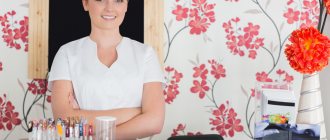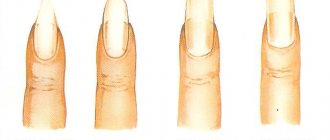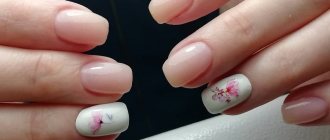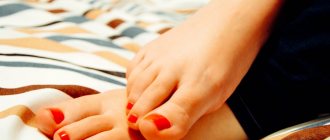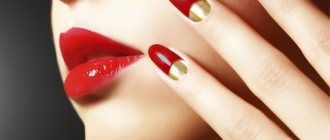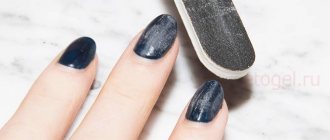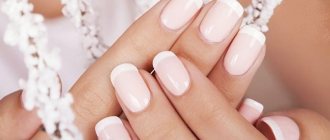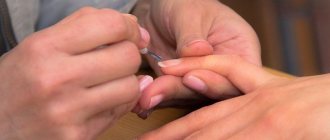From this article you will learn:
- Which manicurist tools are subject to disinfection?
- What are the stages of the process of disinfection of manicure instruments?
- What devices exist for sterilizing manicure instruments?
- What disinfectants are best for a master to use?
- How often should manicure instruments be disinfected?
- How to disinfect manicure instruments at home
Many manicure lovers mistakenly believe that disinfecting manicure tools is just a second spray with a special product. The situation is darkened by the fact that unscrupulous craftsmen treat them this way. Obviously, this method will not give the desired result - it will not ensure complete security for the client.
Manicure devices easily transmit HIV, hepatitis and herpes. Therefore, the main thing in the work of nail masters is to take care not to cause harm to the client. To do this, it is enough to perform a number of hygiene procedures. In this article we will talk about how to disinfect manicure tools.
Disinfection of which manicure instruments is mandatory?
Nail scissors, clippers and many other devices easily carry dangerous infections. These include deadly viruses. Before starting work, each technician is required to undergo training on disinfecting equipment. However, numerous SES checks indicate that for the most part these rules are ignored.
The most common mistakes are the lack of certified means for disinfecting manicure instruments, incorrect processing methods, and a lack of sets of tools (the minimum number of sets is 3).
Most of the equipment on a nail technician’s table requires thorough disinfection.
So, you need to process:
- scissors;
- wire cutters;
- pusher;
- nail brush;
- buff, files for natural and artificial surfaces;
- manicure table, roller, tray;
- LED or UV lamps;
- dots;
- reusable forms for nail extensions, etc.
In addition to disinfecting manicure tools, the master must take care of the cleanliness of his and the client’s hands, as well as the sterility of the room.
First, let's look at the processing of tools in beauty salons.
Disinfection takes place in four successive stages:
- Cleaning from contaminants. After using manicure tools, you need to remove any remaining cream, oils, or skin flakes. This can be done with water, napkins or brushes.
- The next step is to use a disinfectant for manicure tools. It kills harmful viruses, bacteria and fungi.
- Next, all instruments are sterilized in a special apparatus.
- An obligatory part of disinfection is thorough cleaning of the hands of the master and the client with an antiseptic.
After you have rinsed your tools with water, dip them in the disinfectant solution. Below we will consider what is best to use as disinfectants.
Next, wash all the devices again, dry them thoroughly and process them in a sterilizing machine. Be sure to follow the instructions for your device.
When disinfecting your hands, consider the following rules:
- It is better to use spray products;
- free your hands from rings, watches and bracelets, roll up your sleeves;
- the product must be applied in a non-contact manner;
- fold your hands into a boat shape;
- When disinfecting, do not miss areas of skin between the fingers, the backs of the hands, and the nail bed;
- It is better to purchase disinfectants that can restore the fatty film of the skin, otherwise you may experience dry skin.
Read material on the topic: Therapeutic pedicure: advantages and disadvantages of the procedure
Disinfection methods
In addition to alcohol and disinfectants, various devices are used to sterilize instruments to remove fungus and microbes:
- sterilizers;
- tendon;
- boiling utensils;
- ovens.
Each technique involves cleaning and deep cleaning manicure supplies to protect your fingers and nails from infection. Some devices and techniques can be used independently, others are suitable for nail salons. When serving a client in a salon, sterilization of instruments is a mandatory procedure.
Using special devices
Special devices for sterilization are one of the methods used in beauty salons, where workers have a large flow of clients and there is no way to quickly and efficiently clean the equipment after a manicure. The devices are expensive, so not everyone can afford to buy one for home. These include devices presented in the table below.
| Device | a brief description of |
| Sterilizer | The camera of the device cleanses harmful microorganisms with UV rays or steam. |
| Sukhozhar | Treatment with temperature |
The choice of processing technique is based on ease of use and the amount of work in the salon.
Sterilizers
- There are two methods of sterilization: ultraviolet light and heat treatment.
They are a device with 1 or 2 chambers. Ultraviolet disinfectants neutralize instruments using UV radiation; thermal - they spray the devices with hot steam. It is enough to put the devices into the chamber after manicure, close the lid and start the disinfection process. Different manufacturers include different exposure intervals in devices. Before placing in the sterilizer, make sure that the instruments are dry.
Sukhozhar special
It differs from the operating principle of a conventional oven. They are used exclusively for metal devices; no other material can withstand those temperatures and is deformed. The heating temperature in the cabinet is 300-500 degrees. The approximate time of sterilization with dry heat is 20-60 minutes, depending on the initial temperature. After undergoing such disinfection, the devices are placed either in a UV cabinet or in a tightly closed container. With this method, the tools do not become dull.
Treating tools against nail fungus at home
At home, appliances must be cleaned. Due to the fact that they are used irregularly and by a small circle of users, it makes no sense to buy special devices. It is enough to use traditional cleaning methods that help destroy the fungus and protect your hands from infection. Often women use alcohol or alcohol-containing solutions for these purposes, boiling or disinfecting in the oven.
Alcohol and other substances for sterilization
You need to treat your tools and hands with alcohol every time before and after a manicure. Instead of a regular alcohol solution, you can use cologne, vodka, alcohol-based antiseptic, or boric acid. Before the procedure, it is advisable to wash your hands with antibacterial soap. The surface of the device can be wiped with alcohol using a cotton pad or filled with alcohol.
Boiling manicure equipment
A simple and effective method for disinfecting instruments. To perform this you will need distilled water, which is brought to a boil. With the help of tongs, metal manicure devices are placed, which are not afraid of temperature. They remain in the water for 15-20 minutes, after which they are removed with tongs. Then they are laid out on a clean towel, without touching the surfaces to each other. After drying, they are packaged in an airtight container.
Oven disinfection
To sterilize instruments at home, women use a kitchen oven. It is preheated to 180-220 degrees. At this time, the devices are washed under running water using detergent. Next they are laid out on a baking sheet with a small distance between them. Leave the oven for 20 minutes. After this, they are removed with a potholder or tongs. Cooled instruments are closed in a special storage container.
Source
The most popular devices for sterilization and disinfection of manicure instruments
Dry heat cabinet
This is the most commonly used device for disinfecting manicure instruments. The cabinet structure is similar to a conventional kitchen oven. The basis of sterilization is heat treatment. Temperature ranges from 180 to 260 °C.
The residence time of manicure tools in a dry-heat cabinet is from 60 to 120 minutes. Despite the visible advantages of this device (reasonable price and spaciousness), it has a number of disadvantages. Firstly, the device requires a lot of energy to operate. In addition, very long heat treatment deforms the tool materials.
Autoclave
The structure of an autoclave is similar to a double boiler. In terms of its properties, this device for disinfecting manicure instruments is clearly a leader compared to a dry-heat oven.
Its main advantages:
- minimum processing time;
- low energy consumption;
- maintaining the quality of the instruments.
All this is achieved thanks to correctly selected parameters: pressure of 3 atm, humidity (distilled water steam) and temperature (134 ° C). The disadvantage of an autoclave is its high cost.
This device is also inconvenient because only distilled water is suitable for its operation. Aggressive chemicals contained in tap water damage appliances and the device itself.
Kraft bags
Before processing in a sterilizer, instruments are placed in craft bags and sealed with paper clips. After disinfection, manicure instruments remain sterile for another three days. Sealed Kraft bags remain clean for longer – 20 days, and heat-sealed bags – 30.
Glasperlene sterilizer
The advantages of a glasperlene (“ball”) sterilizer are compactness, low price and incredibly high disinfection speed – 15–180 seconds.
However, this device has a number of disadvantages:
- The disinfection process involves dipping manicure tools into quartz. Due to interaction with this material, highly abrasive files become dull over time.
- The balls require fairly frequent replacement (once every six months to a year), since over time quartz loses its heat-conducting properties.
- A significant disadvantage of the glasperlene preparation is that it only treats the working part of the instruments. The handle is not disinfected.
The FDA does not recommend using quartz beads to disinfect manicure instruments.
UV and ultrasound
Sometimes such devices are also classified as sterilizers. However, they have a slightly different purpose: an ultrasonic device is usually used to prepare manicure instruments, and an ultraviolet device is used for storage after the disinfection procedure.
Recommended articles on this topic:
- Where to buy nail files
- How to choose a manicure set for a beginner master
- Professional pedicure files
Disinfection and sterilization of manicure instruments
Updated and expanded 05/22/2019
A sterile manicure instrument is the key to the health of the master and clients. This is worth remembering for both beginners and experienced nail salon employees.
A safe manicure begins with treating your hands with an antiseptic and is performed with sterile instruments. The procedure for processing instruments in a nail salon is carried out in three stages: disinfection, mechanical cleaning and sterilization. Let's look at the features of each of them in detail.
Treating hands with antiseptic
Before performing a manicure, you must disinfect your hands and the client’s with a disinfectant. To do this, you can use the following antiseptics: Neosteril, Octenisept, Bacillol, Sterillium, Kutasept F, Eco-breeze. They come either in sprays or in containers with dispensers.
The product is applied to dry hands and distributed evenly over the skin. It is important to carefully work on the inside and back of the hands, the areas between the fingers and around the nails. After this, it is recommended to wear disposable latex or rubber gloves.
Next, the client’s hands are treated with an antiseptic. Use hand sanitizer twice if there is a risk of contracting hepatitis B or tuberculosis.
Recommendations for antiseptic treatment
- The antiseptic is taken from the dispenser into the recess of the palm
- Nails should be clean and cut short
- When working, it is necessary to remove rings, bracelets, watches
- When applying antiseptic, the skin of your hands must be dry.
- It is recommended to use an antiseptic with components to restore the lipid layer so that the skin does not dry out excessively and is less susceptible to injury and cracking.
- The antiseptic is rubbed into the skin of the hands until completely dry.
Disinfection of manicure instruments - the first stage of treatment
Disinfection is the destruction of bacteria, viruses, fungi and any other microorganisms from working manicure tools and surfaces. It is the first stage of processing.
There are three of them: disinfection , pre-sterilization cleaning and the final one – sterilization .
For disinfection in salons and when professionals work at home, a chemical method is used.
It is based on the use of special disinfectants in the form of solutions, tablets, and aerosols.
They should have a wide spectrum of effects, which includes antifungal and antiviral effects. The products can be purchased ready-made, or the concentrate can be diluted in the specified ratio.
The ratio is different for each disinfectant, so you must follow the instructions or recommendations of SanPiN. Good disinfection liquids should contain anti-corrosion additives.
Containers with ready-made and prepared solutions must have lids and stickers with the name of the disinfectant, concentration and date of preparation during storage.
Each salon or home technician chooses for himself which disinfectant to use. There is also a list of drugs recommended by SanPiN.
Features and choice of ultrasonic washing
Means for disinfecting manicure instruments when working at home and in beauty salons
After performing a manicure or pedicure, disinfection is the first stage of treatment. Let's look at the most popular options for disinfectant solutions and concentrates. The higher the price of the product, the safer the composition for metal tools is considered.
Before disinfection, all instruments or devices are opened, complex mechanisms are untwisted and immersed in the solution.
It is necessary to ensure that there are no air bubbles or voids left on the surfaces that would prevent the penetration of the product.
Gigasept AF – intended for disinfection of manicure and medical instruments. The prepared solution can be used within 7 days. If it changes color, you need to prepare a new one and discard this one.
Gigasept AF can also be used for pre-sterilization cleaning, the second stage of processing. In this case, after soaking the equipment in the solution, it is enough to rinse it under running water for 10 minutes and additionally immerse it in distilled water for 1 minute. Instruments must be completely dry before sterilization.
Korzolex Plus - can also be used for two stages, disinfection and cleaning before sterilization. The untwisted instruments are lowered into the solution prepared according to the instructions, and the recommended disinfection time is maintained. Then cleaning with a brush is carried out in hard-to-reach places and rinsing with running and distilled water.
After preparation, the solution is recommended for use for no more than 5 days. Both the first and second products can be used in ultrasonic washing baths with metal containers.
Alaminol is a broad-spectrum disinfectant concentrate. The finished solution can be used for no more than 10 days or until the appearance changes. Suitable for use in ultrasonic installations. Dilute strictly according to the instructions, wearing gloves.
Details about choosing a disinfectant:
How to choose a disinfectant, review of the best
Step-by-step instructions for disinfecting manicure tools
Please note that disinfection of manicure instruments is carried out immediately after completion of the procedure. They cannot be washed with water, wiped, or brushed off anything with a brush, so that skin residues and other particles or components do not rise into the air or splash with running water on you and in the room.
The disinfection procedure is carried out in 3 successive stages:
- All tools are disassembled and untwisted
- Placed in a pre-prepared bath or disinfection unit with the selected solution
- The time recommended for disinfection with each specific solution is maintained.
The liquid must cover the instruments to 2 cm above them for proper processing. Any manipulations with disinfectant solutions are carried out wearing protective gloves. For practical use and economy, it is better to choose a disinfectant that can also be used for pre-sterilization cleaning. She is the next stage.
Pre-sterilization cleaning of manicure instruments - the second stage of processing
After the period of exposure of the instrument to the disinfectant has expired, it is removed from the solution and cleaned using regular or brass brushes, as well as cotton pads under running water for 10 minutes. Not only dirt and small particles are washed away, but also the disinfectant itself, which damages the instruments with prolonged exposure.
The recommended washing time can vary from 1 to 10 minutes, see the instructions for the drug. After cleaning instruments under running water, it is recommended to place them in distilled water for a minute to neutralize any remaining disinfectant solution.
The first and second stages can be combined in two cases:
- Chemical disinfection and cleaning, where a disinfectant solution simultaneously dissolves dirt and particles. All that remains is to rinse everything and dry it before sterilization.
- Disinfection and cleaning in an ultrasonic cleaner. The combined effect of the solution and vibrations allows you to fully prepare the instruments for sterilization. After exposure, we also rinse everything with running water.
Sterilization of manicure instruments - the third stage of processing
The purpose of sterilization is the complete removal of all microflora remaining after the previous stages of processing.
There are several options for sterilization - thermal, chemical, steam, quartz. According to SanPiN, temperature and pressure treatment in a dry-heat oven, autoclave or infrared sterilizer are considered the most effective.
For commercial purposes, only sterilizers that have a registration certificate from Roszdravnadzor are allowed to be used in beauty and manicure salons. This applies to sterilizers of any type.
A sterilizer that has such a certificate is included in the State Register of Medical Devices of the Federal Service for Surveillance in Healthcare. You can check the availability of any sterilizer in this register on the website https://www.roszdravnadzor.
ru/services/misearch. Be sure to check sterilization equipment before purchasing.
Here we have described which dry roasts have a registration certificate and which do not.
How to sterilize manicure instruments in a dry heat oven
Dry instruments, after disinfection and thorough cleaning, are placed in special craft bags with color indicators and then sent to the cabinet. If there are no craft bags, you can unfold the tools with tweezers. Sterilization occurs due to exposure to high temperature, from 121 to 180 ° C for 30 minutes.
This sterilization option is also suitable for processing cutters used in hardware manicure.
How to sterilize instruments in an autoclave
The installation is more expensive than a dry-heat oven and is suitable for large salons or clinics. Sterilization occurs due to exposure to steam and high temperature from 121 to 137 ° C under a pressure of 1.5-2 atmospheres. Lasts 20-30 minutes. Distilled water is used.
The full cycle of operation of the autoclave includes: heating-sterilization, cooling of the instrument. The whole process will take about 50-55 minutes.
The advantage of an autoclave is the ability to process any products and manicure tools. Compared to a dry-heat oven, a number of materials that are destroyed by high temperatures cannot be placed in it.
For autoclave processing, paper or plastic bags are used. Plastic ones are transparent, cost a little more, but keep the instrument sterile longer.
According to SES standards, when sterilizing with an autoclave, a sterilization quality log must be kept. To fill it, test strips are purchased, which are placed on bags or inside bags with instruments during each sterilization. After the processing cycle, stickers with color indicators about the quality of the procedure are transferred to the journal.
According to the European standard, autoclaves are divided into 3 classes:
Category N devices are not recommended for nail salons, as packaging cannot be used in them.
They process all-metal objects without planes and channels, as well as fabric.
These models do not have preliminary vacuumization and drying, so the bags turn out wet after sterilization. There can be no question of any further storage of wet Kraft bags.
Autoclaves of categories S and B can be used for work in a salon or nail salon. They provide vacuumization and drying, and you can process tools in bags.
The full cycle of operation of the autoclave includes: heating-sterilization, cooling of the instrument. The whole process will take about 50-55 minutes.
Autoclave - features, selection and operating rules
Infrared sterilizer
There are only two models of infrared sterilizers approved by Roszdravnadzor on the market:
The price of each is about 50,000 rubles. Processing in devices occurs under the influence of a temperature of about 200 degrees, but since this is infrared radiation, the metal does not deteriorate.
ST -IK RELMA provides packaging. It is reusable and expensive. Also included is a stand for cutters.
Processing is extremely fast: 10 minutes for packaged and 6 minutes for unwrapped instruments. The packaging remains sterile for 1 day.
For the infrared sterilizer, it is also necessary to maintain a Quality Log. 1st class indicators are glued to the bags. They connect the packaging lid to the main part. One indicator is enough for one.
There are also 5th class indicators for infrared sterilizers. They are inserted directly into the packaging, and after processing they are pasted into the magazine.
Choosing an infrared sterilizer - review of models
for the ST-IK MAI . Instruments are processed open and must then be used immediately or stored in sterile boxes, a sterile cabinet or a UV sterilizer.
Chemical sterilization
A method carried out using special solutions. Must be performed under sterile conditions using sterile containers, rags, and tweezers for contact with instruments.
Conditions must be created for further sterile storage. The result is valid for 3 days.
It is not always effective in everyday life in nail salons, however, it is the best backup option if all conditions of the procedure are met.
Quartz, ball or glasperlene sterilizer
It has both pros and cons. Pros:
- rapid sterilization under high temperature, takes 20 seconds
- mobility – convenient to use by one specialist in the salon, at home and on the road
- possibility of sterilization of cutters for hardware manicure.
Minuses:
- incomplete immersion of the instrument into the treatment area (balls), and as a consequence the risk of re-spread of pathogenic microflora
- The operating temperature of the device does not always correspond to the declared one, which leads to incomplete sterilization
- the need to replace balls every six months, which many craftsmen are not aware of
- rapid wear of cutting parts due to frequent contact with hard balls.
Properties of glasperlene sterilizer and rating of the best
- Ultrasonic sterilizer , despite its name, is intended for the first two stages - disinfection and pre-sterilization cleaning.
- The ultraviolet sterilizer is intended only for storing already sterilized instruments.
Processing of manicure instruments according to SanPiN
Source: https://nails-mag.ru/zdorove/dezinfektsiya-i-sterilizatsiya-instrumentov-dlya-manikyura/
Disinfectants for manicure instruments
To thoroughly disinfect manicure instruments, you need to perform several procedures. The first of them is to clean all accessories from dirt, skin flakes and biological fluids. To do this, wash the device in running water with regular soap. Next, the devices are sent to a sterilizer for processing. This is where harmful bacteria, viruses and fungal infections are removed.
Then the tools are placed in craft bags. The final stage of processing is before use. Before a manicure, the hands of the master and client, the working surface of the table and tools are also disinfected.
The following drugs are used for this:
- "Neosteril colorless." This liquid for disinfecting manicure instruments and surfaces has a high speed of action. The composition of neosteril quickly neutralizes harmful viruses (including AIDS), fungus, hepatitis, rotaviruses and other infections. The product contains alcohol.
Neosteril colorless dries quickly and does not need to be washed off. After treatment, there is no need to ventilate the room - you can use the product in front of clients.
- "Neosteril blue" . The product is intended for disinfecting the hands of visitors and nail professionals. The solution has wound healing properties. It is safe, does not contain allergic substances, and does not irritate the delicate skin of the hands. You can wipe your hands with this solution before each manicure procedure without any fear.
- “Dezecon”, “Dezefect”, “Dezecon-OM”. These products are used to disinfect manicure instruments. All three liquids are degreasing. The solutions are poured into the bath, where the devices are lowered. After disinfection, rinse the instruments additionally in running water.
The shelf life of “Dezekona” is one month, “Dezefecta” and “Dezekona-OM” are two weeks. After this period, the solutions must be replaced with new ones.
Read the material on the topic: How to choose a manicure table that meets all the necessary characteristics
How often should manicure instruments be disinfected?
Based on the material used, manicure tools can be divided into two categories: porous and non-porous. The first ones are disposable. If they are used more than once, they require special disinfection. Non-porous instruments are designed to be reused. They are easy to clean from dirt and bacteria.
Different technologies and cleaning agents are suitable for disinfecting manicure instruments of porous and non-porous structures. Therefore, the first step is to determine what type of equipment you have.
- Porous manicure tools include fabric, wood and absorbent ones: nail files, sponges, cotton swabs and orange swabs, paper napkins and towels, and polishing buffs. All of them can only be used once. However, some paper nail files are quite suitable for reusable use. But here you should be careful and observe how they react to disinfection. If the material breaks down, it is better to throw away the nail file.
Cloth towels should be washed every day (after completing work with clients). The use of powder is mandatory.
- Non-porous manicure tools include those made of metal, plastic, glass or fiberglass. These can be manicure cutters, tongs, scissors, brushes. All equipment must be thoroughly cleaned after each visitor. Rules for disinfecting these manicure tools can be found above.
- Attributes that do not come into contact with the skin do not pose a threat of harmful viruses or infections. These include regular varnishes, gel varnishes, acrylics and other similar compositions. All of them do not need disinfection.
Read the material on the topic: How to open a manicure salon: step-by-step instructions
How often should I clean?
Nail salons sterilize tools after each client, using special devices. Washing instruments with water is not disinfection. At home, if a person takes care of his nails on his own, he should wipe the scissors and abrasive files with alcohol after the procedure. The manicure set (which has been in use) is disinfected monthly in distilled boiled water. If more than one user does a manicure with these tools, they need to be boiled before and after use.
Disinfection of manicure instruments at home
There are fewer rules for disinfecting manicure instruments at home than in a salon, but you should not neglect them. Devices for home manicure are treated with ethyl alcohol or chloramide. You will also need sterile gauze or wipes.
Stage 1. First, prepare all the manicure tools that you want to process.
Step 2: Remove dirt.
Step 3. Next, pour ethyl alcohol into a small container. Put your tools in there.
Step 4. After half an hour, remove the devices and rinse them in running water.
Stage 5. After complete drying, place the tools in an oven heated to +200...+250 °C. Then turn off the oven and wait for your appliances to cool.
Drying in the oven is still unable to destroy all viruses and infections. Therefore, this type of disinfection is only suitable for home manicure instruments that have only one owner. If you work as a nail technician at home, you need to purchase a sterilizer.
When disinfecting manicure instruments at home, follow these rules:
- When drying in the oven, you need to leave a small distance between the tools.
- After drying, you should wait until the devices have cooled down. This will help avoid burns.
- There is no need to speed up the cooling of the devices (immerse them in cold water, etc.). It's better to let them cool down on their own.
- When purchasing sterilizers and antiseptics, pay attention to the quality of the samples. After all, you care about your safety and that of your visitors!
If you conscientiously follow all disinfection requirements, your instruments will retain their quality longer.
Previously, boiling was mainly used to disinfect manicure instruments. The advantage of this method is that exposure to high temperatures destroys harmful viruses and infections. However, many materials begin to deteriorate with frequent and long heat treatments. But if you don't have an oven nearby, use boiling.
Bring the water to a boil and lower the appliances into it. They should remain in boiling water for about 15 minutes. Using sterile forceps, remove the instruments and place them on a paper towel. After drying, place the treated devices in craft bags.
It is better to use UV sterilizers for storing devices. They are equipped with special bactericidal lamps.
Disinfection of manicure instruments is the basis of the entire disinfection process. These rules are mandatory for home and salon nail artists. You should not ignore the treatment of devices when doing your own manicure. Thorough sterilization is the key to the safety and good attitude of visitors.
Read material on the topic: Which nail file is better - a review of the most suitable options
How to treat manicure tools against nail fungus?
To avoid becoming infected with fungus after a manicure, it is necessary to treat nail files and other tools. Disinfection with alcohol is carried out immediately before and after the procedure. The master in the salon does a manicure wearing gloves and disinfects the client’s hands. They use special devices: sterilizers and dry heaters. At home, such sterilization is less necessary. Women use sterilization solutions, boil or heat instruments in the oven. After sterilization, manicure devices must be stored properly.
Where to buy disposable nail files that do not require disinfection
Among the huge number of online stores offering manicure accessories, we invite you to our “WORLD OF NAILS”! You should choose our services because:
- “MIR FILOK” – own production of nail files.
- "WORLD OF FILES" is the main supplier!
- The showroom is located in Moscow.
- Delivery throughout our vast Motherland!
Why is “WORLD OF FILES” the best option for purchasing a product for you?
- Our store is built on our own production of saws. Thanks to this, you get: minimized cost of service, tested and confirmed product quality, fast production, attractive conditions for distributors.
- Our nail file is made only from materials that have repeatedly proven their quality (South Korea).
- Wide variety of product. Thus, a manicurist with any level of professionalism will be able to satisfy his interests.
- You can figure out which file is right for you. We carry out individual orders.
- Another advantage is the application of your brand logo on the working surface of the files.
